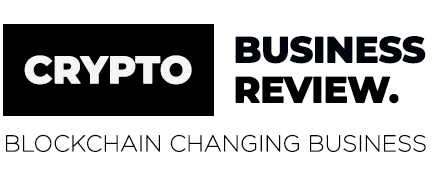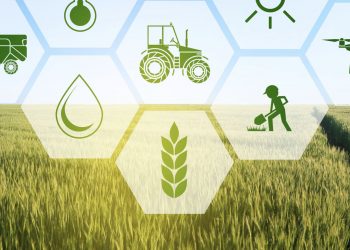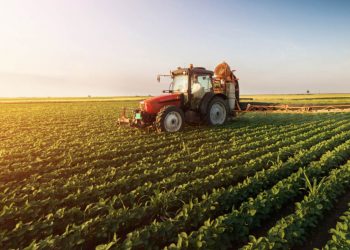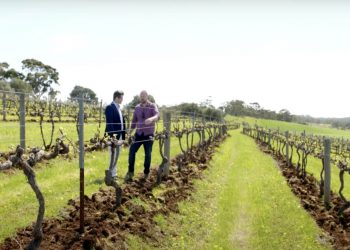*This text is part of “Blockchain for Agriculture: Opportunities and Challenges”, edited by Gerard Sylverster and published by the United Nations Food and Agriculture Organization and the International Telecommunications Union
Since 2016, AgriDigital has pioneered, non-commercially so far, the use of blockchain across agricultural supply chains. Conducting the world’s first proof-of-concept (PoC) algorithm with leading agricultural businesses, AgriDigital has deep domain expertise in blockchain technology and applies blockchain and related technologies to solve the embedded agri-supply chain challenges.
The company operates primarily along grains supply chains. As its founders have over 80 years combined experience in the Australian grains industry, this was the natural first market. AgriDigital is expanding rapidly into the global grains industry, and across commodities with initial trials underway in the rice and cotton industries.
AgriDigital has a cloud-based commodity management solution in marketing for the global grains industry. It connects grain farmers, buyers, site operators and financiers through a single platform, allowing them to contract, deliver and make payments securely and in real time. Although the AgriDigital platform is cloud based, it is also blockchain enabled, meaning it acts as a user interface with the blockchain protocol layer. With the launch of a commercial blockchain protocol for agriculture, the AgriDigital platform will operate as the primary application layer for users to interact with the blockchain.
The company has developed a library of smart contracts operating on the blockchain protocol, allowing users to trade, finance and trace agri-commodities. At the core of AgriDigital’s solution is the creation of digital assets. Using digital assets, AgriDigital brings together the trade, finance and data flows that are often disparate in traditional, paper based agri-supply chains. This provides users with a more informed and robust view of their assets and the supply chain, and improves liquidity, transparency and security for all supply chain participants including farmers, traders, producers, financiers and consumers.
The company is dedicated to building a robust digital infrastructure that connects the physical commodity to the digital representation at every stage along the supply chain. In doing so, AgriDigital uses the Internet of things, sensors and integrations with machinery such as weighbridges wherever possible.
AgriDigital is an Australian company based in Sydney. The company’s blockchain solution has been trialed at a number of locations across Australia including Dubbo in New South Wales and Bordertown in South Australia. The customers are grain farmers, buyers, site operators and financiers. The initial target market for the company’s commodity management solution is the global grains industry. However, the blockchain solution is designed to operate for a full range of commodities and the company works across grain, rice, cotton and livestock.
The company has worked closely with a number of major participants in Australian agriculture to test the blockchain protocol and the smart contract library. These include: Fletchers International Exports; CBH Group, Australia’s largest exporter of grain; and Rabobank, the
largest global agri-bank.
AgriDigital’s award-winning SaaS34 platform has a network of 1,300 active grain supply chain users with a broader network of over 4 500 total users. To date, over 1.6 million metric tons of grain have been transacted by these participants on the AgriDigital platform (since November 2016). These users will be transitioned to using the blockchain protocol once it is launched commercially.
AgriDigital was founded in 2015 with a vision to solve three key challenges across agri-supply chains:
- farmers are not paid for the commodities they produce when they deliver them;
- buyers don’t have access to flexible supply chain finance to pay farmers, as financiers lack visibility and control when financing commodities;
- consumers don’t really know where their food and fibres come from thus restricting their ability to make informed purchasing abilities
Buyers and sellers along agri-supply chains cannot operate with confidence, knowing that they will be paid and can access the finance necessary for business stability and growth.
This finance is often limited to highly reputable borrowers with bricks and mortar security, and is often only accessible for commodities where the risk price can be hedged. This results in settlement latency, with title transferring months before payment is made. This introduces enormous counterparty risk that most often falls on the producer at the start of the supply chain.
Supply chain participants are vulnerable to fraud, with global food fraud costing USD 40 billion annually and global trade in fake goods accounting for a staggering USD 500 billion annually.
Without verifiable and data rich assets, counterfeit goods move in large quantities across supply chains. The real cost of this to the end consumer is abundantly evident, with food security a growing issue. Indeed a number of high profile food contamination cases have had global impacts.
AgriDigital is addressing these challenges by providing a digital infrastructure that brings trust and transparency to supply chain participants. The company started with the first transaction along many supply chains, with the sale from the farmer to the buyer. Blockchain technology was immediately identified as a tool for building creative and innovative solutions to solve these problems. However, blockchain is only a piece of a larger digital infrastructure, one that allows users to easily access the protocol layer and that ensures the information that is recorded truly represents the state of the physical commodity in the real
world.
So far AgriDigital has conducted three key blockchain pilots:
- AgriDigital and Fletcher International Exports, December 2016
- AgriDigital and CBH Group, July 2017
- AgriDigital and Rabobank, December 2017
AgriDigital and Fletcher International Exports
A beta version of the AgriDigital platform was launched in 2016 which functions as the application layer for users to interface with the blockchain. The AgriDigital platform streamlines and automates business processes for farmers and buyers, seamlessly capturing valuable data about the physical commodity and facilitating data transfers and reconciliations. The platform itself has offered an enormous leap forward in commodity management software, which, as a cloud-based platform, is a huge step up from spreadsheet and paper based systems or large enterprise solutions otherwise used.
AgriDigital’s team of software engineers and agribusiness professionals have designed a platform that caters for the intricate needs of grain traders and farmers. Using the platform, the company’s users can create contracts, deliveries, make payments, generate invoices and manage on-site inventory. Developing this platform required a lot of hard work and testing.
The company’s beta customer, Fletcher International Exports, played a critical role in testing the platform in its very early stages. Ensuring the blockchain protocol and platform integrate seamlessly has had its challenges, in particular making certain that AgriDigital is making the most of the comparative advantages each technology offers.
Blockchain technology has developed enormously over the past few years, and AgriDigital has been continuously updating its solution in line with the latest developments. In December 2016, the company executed the world’s first settlement of a physical commodity on a blockchain. It set out to use blockchain technology to provide real-time settlement, that is payment on title transfer for physical grain deliveries to a selected buyer. The pilot ran on a private instance of the Ethereum network.
A smart contract from the proprietary AgriDigital library auto-executed the settlement by first valuing the delivery, then verifying that the buyer had sufficient funds to pay the grower, and then securing the funds in the grower’s name pending delivery. Once the grower made th physical delivery at site, title to the grain transferred from the grower to the buyer as the grower payment was simultaneously created from the reserved funds. For this pilot, although the transaction settlement occurred on the blockchain, the grower received the payment in local currency using traditional banking methods: a message was sent out as a bank file for the buyer to upload and pay, on the same day, via existing mechanisms with its bank. Typically, payment terms in the Australian grains industry range from two to five weeks, and it is these terms that pose counterparty or credit risk to growers.
AgriDigital and CBH Group
AgriDigital and CBH Group, Australia’s largest exporter of grain, conducted a pilot to test the application of blockchain in the Australian grain industry at CBH’s wholly owned subsidiary, 28 Blue Lake Milling, an oats processor in Bordertown, South Australia.35 Three scenarios were conducted using the AgriDigital commodity management platform and blockchain application.
Throughout this pilot there were two key objectives:
- to generate digital title to a physical commodity and execute payment on a blockchain including functionality to allow for secure seven days payment terms; and
- to use blockchain to verify a batch of organic oats by tracing the movement of organic oats from the farmgate, through processing and milling to a retail customer.
The pilot used a three node, private Quorum network. This allowed the use of advanced privacy settings and transaction time. The grower delivery was received at site using the AgriDigital platform, where information about the quantity and quality of the oats was recorded. This information was pushed through various integrations, generating a digital title token on the blockchain held in the grower’s digital wallet. This token was held and flagged for payment in seven days.
A week later, settlement occurred in an atomic (simultaneous) transaction with payment being made to the grower at the same time as the title was transferred from the grower to the buyer. The payment on the blockchain layer was made using a second token, minted by AgriDigital and known as “Agricoin”, which was pegged one to one with the Australian dollar. Smart contracts, agreements codified for execution on a digital distributed platform, were used to auto-execute payment on the blockchain layer which was parallel processed using traditional banking methods. Without a broadly accepted digital currency, and as many
cryptocurrencies are too volatile for many businesses to hold on a balance sheet, AgriDigital has continued operating using parallel processes.
The Quorum network uses the Raft consensus mechanism, which allowed AgriDigital to process four transactions per second, a settlement rate easily scalable to process all transactions in the Australian grains industry on a blockchain.
In another scenario, a Web application and the AgriDigital platform were used to record essential data on the provenance, storage, transport and batch treatment of the oats. These data points were bundled into various assertions, with each assertion representing an event or claim critically pertaining to the organic oats. The assertions were then hashed and recorded on the blockchain layer. Using a complex analytics model, AgriDigital were able to scan a QR code at the point of sale that produced a report either confirming or denying the organic status of the oats.
A key challenge faced by the bulk commodity supply chains has been providing clear visibility over commodity ownership. Paper-based systems or spreadsheets provide little to no security for growers when payment fails. Being able to match title transfer to payment provides instant benefits to growers and all sellers through reduction of counterparty risk and increased security over the asset up until title transfer.
A further challenge has been ensuring the quality of the data posted to the blockchain. Where the blockchain or the blockchain application such as AgriDigital can easily integrate with machines and digital systems, such as weighbridge integration and quality testing instrumentation or processing equipment, this is clearly preferred. Removing human data input and increasing the number of such integrations allows for much more reliable data entry and increases the integrity of the blockchain overall.
Farmers’ story
AgriDigital’s initial blockchain pilot in 2016 executed the world’s first settlement of a physical commodity on a blockchain. The pilot captured real-time data of a grain sale between a grain grower and a buyer, and then executed that transaction on a blockchain. The grower was David Whillock of Whillock Pastoral Co Pty Ltd who delivered a load of wheat comprising 23.46 metric tons to Fletcher International Exports (FIE).
For Whillock, the delivery was business as usual, arriving at the site in Dubbo, moving across the weighbridge and testing the quality of the grain at the sample station. However, at the moment of taring off at the weighbridge, the settlement occurred on the blockchain and simultaneously the payment was created: a global first for the agriculture industry.
“The new blockchain technology will benefit farmers such as Whillock Pastoral Company by providing fast and secure payment of grain,” commented David Whillock, “knowing that we will be paid on delivery will assist in maintaining regular cash flow, helping us better and more confidently manage our business”.
Fletcher International Exports (FIE) was the first customer on board AgriDigital’s blockchain enabled commodity management platform. According to Rodger Fletcher, Chairman of FIE, “We never want to see another IT guy in here who doesn’t understand the industry and our business. Things are changing fast and we’re excited to have AgriDigital as our technology partner for the future.”
FIE was founded in 1967, and over the last 50 years has earned a global reputation for innovation and leadership in the agriculture industry. (From the first abattoir in Australia to implement carcass inverting, leading the movement in paying employees electronically, to building an inter-modal freight depot with a direct service to the export container terminal in Sydney on their own trains, FIE has always been at the forefront of the industry. As CFO Kent Dickens explains, “Chairman Roger Fletcher is a true innovator who is always happy to try new ways of doing business, especially when it can help the industry or find new ways to deliver value.”
FIE decided to use AgriDigital’s commodity management solution for the 2016-2017 harvest after struggling to manage and account for grain ownership on their existing system. At the same time, FIE was planning to roll out a new site plan to manage deliveries during harvest more efficiently, and were looking to implement a commodity management IT system to support the new process and manage ownership issues. According to Corporate Accountant Elizabeth Mitchell, FIE chose AgriDigital because of the team’s diverse technical and industry expertise. “When [founders] Bob, Ben, and Emma approached us, we were confident in their agriculture and grains knowledge, and knew that they had the right experience to deliver
a solution for us.”
FIE continues to use AgriDigital’s commodity management solution to handle contracts, deliveries, invoices, cash prices, and payments throughout the grains harvest. FIE also uses AgriDigital as a customer-facing platform to manage their business communications with farmers, including SMS notifications to alert farmers of deliveries. “The intuitive way that AgriDigital helps us to deliver information to our farmers has been great for us, and for the farmers. SMS notifications remove a lot of pain for us – our farmers don’t need to ring up anymore, because they just know what’s going on,” said Elizabeth Mitchell. According to Kent Dickens, improving the flow of communications, “fostered better relationships with our farmers, and gave them confidence that FIE will be here for them in the future and are prepared to invest in technologies that make the industry better.” Jake Young, Office Manager for FIE, was involved in the decision to implement AgriDigital instead of a custom IT solution. Young explains, “ultimately AgriDigital was cheaper, faster, easier to use, and provided more
functionality.”
Source: http://www.fao.org/policy-support/tools-and-publications/resources-details/en/c/1178062/






Some really great articles on this website , appreciate it for contribution.